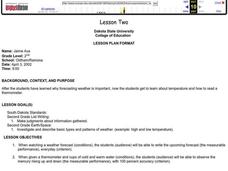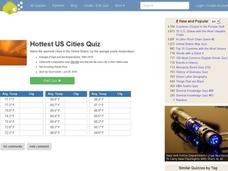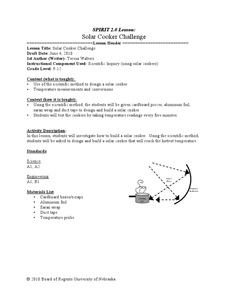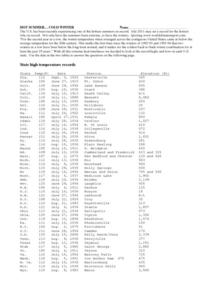Curated OER
The Earth's Atmosphere and Temperature
Students describe and compare the layers of the atmosphere. They explain how to measure the temperature of the atmosphere and discover what causes the atmosphere to heat up in some places more than in others.
Curated OER
Lesson Two
Second graders, after assessing why forecasting weather is important, study about temperature and how to read a thermometer. They experiment being able to observe the mercury rising up and down when given a thermometer and cups of cold...
Curated OER
Weather Dot Com
Students examine the need for a standard unit of temperature and measure temperature with a thermometer. They discuss the details of a thermometer and the calibrations used, record temperature data for inside and outside, explore...
Curated OER
Hottest US Cities Quiz
In this online interactive geography quiz learning exercise, students respond to 20 identification questions about the hottest cities in the United States. Students have 4 minutes to finish the timed quiz.
Curated OER
Solar Cooker Challenge
Students use the scientific method to design a slow cooker. In this experimental method lesson students measure temperatures and conversions of the solar cooker that they create.
Curated OER
Starlight, Star Heat
In this stars worksheet, learners read how astronomers calculate the temperature of a star by measuring its color. Students use a chart showing star temperatures and colors to complete 3 short answer questions.
Curated OER
Temperature: Celsius ELL 18.6
In this identifying comparative adjectives describing Celsius temperature, students read lists of high temperature words and low temperature words and draw lines matching the sentences with the correct pictures. Students match four answers.
Houghton Mifflin Harcourt
Math Skiils: Comparing Integers on a Number Line
Here is an attractive assignment that instructs learners how to compare more than one integer on a number line. After the lesson, three practice problems follow. They require learners to place integers on a number line and then order...
National Wildlife Federation
Stifling, Oppressive, Sweltering, Oh My!
Looking for a hot date? Pick any day in August, statistically the hottest month in the United States. The 15th lesson in the series of 21 instructs pupils to investigate the August 2007 heat wave through NASA data, daily temperature...
Yummy Math
Hot Summer. . . Cold Winter
A table of each state's record temperature reports data that middle schoolers can place on a number line for analysis. A written explanation of how to use this tool and the concept of absolute value are also included. Nine questions are...
Curated OER
Stars Lab
After making a list of top 10 brightest stars, your class will learn to classify the colors of the hottest and coolest stars. The spectral classes will help with understanding of nuclear fusion and the life of a star.
Curated OER
Keeping Warm
Fifth graders measure the temperature of water using a thermometer. They record the temperatures of water on a chart. Students use the temperature data to determine which materials are the best conductors of heat. They discuss their...
Curated OER
Lesson- Colors of Stars
Student describes what happens to the color of a stove burner or a coal as it gets hotter. They use the applet to determine what range of temperatures range give you a red light, what range of temperatures would give you a white light,...
Curated OER
Hertzsprung-Russell Diagram
Learners examine the relationship between temperature and brightness. In this astronomy lesson students will correlate the evolution of stars to the HR diagram plotted.
Curated OER
Breaking News English: The Year 2007 to be the Hottest Ever
In this English worksheet, students read "The Year 2007 to be the Hottest Ever," and then respond to 47 fill in the blank, 7 short answer, 20 matching, and 8 true or false questions about the selection.
Curated OER
Energy from the sun
Students put two thermometers outside on dark and light colored paper and predict which will get the hottest. In this thermometer lesson, students predict and record their results of the hottest thermometer.
National Wildlife Federation
I Speak for the Polar Bears!
Climate change and weather extremes impact every species, but this lesson focuses on how these changes effect polar bears. After learning about the animal, scholars create maps of snow-ice coverage and examine the yearly variability and...
Curated OER
SDO Reveals Details on the Surface of the Sun
In this images of the sun worksheet, students read about the images released by NASA's Solar Dynamics Observatory and they solve 3 problems using the given photograph of the sun. Students find the scale of the image, they compare the...
Curated OER
Tour du Jour?
Students read an article about tourism in Hokkaido, Japan and address the impact of global warming on world wide tourist destinations. They make posters predicting the impact of warmer temperatures on various tourist attractions
Curated OER
Phase Changes
For this science worksheet, students examine the physical changes associated with the change of temperature and mixtures. The answers are included.
Curated OER
Hottest, Coldest, Highest, Deepest: Science, 4th Grade
Fourth graders investigate weather patterns in their home state of Utah. After creating KWL charts, they research weather and geographical data to locate the state's extremes. As an extension, 4th graders write and illustrate books about...
Curated OER
Inside the Earth
In this composition of the earth graphic organizer worksheet, students research the relative temperature and composition of the earth's crust, mantle, and core.
Curated OER
Numbers in the News
Students examine numbers used in the real world by reading newspapers. In this number identification instructional activity, students explore popular newspapers and attempt to find numbers in prices, temperatures, dates, sports scores,...
Curated OER
Weather and Oceans: Uneven Heating of the Earth
Students investigate what causes the heat on Earth. In this Earth heating instructional activity, students experiment with different heat sources and determine where the Earth gathers the most heat. Students explore vocabulary words...

























